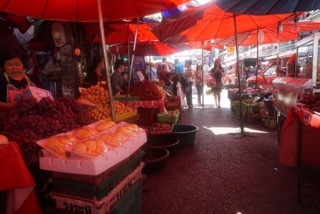 |
Large mural in Lower East Side. An arresting, lifelike image that captures the energy of the area.
It's tough to detect the real people from the illustrated versions. |
I had the unexpected good fortune to spend a few days in New York. With so much to see it's always a challenge to choose but given that the gallery scene is quiet in August I decided to focus on Museums.
I found myself showing up to exhibits about human impulses with expressions of intense passion, articulate renditions, materiality and an over the top obsessiveness. Works that talk about mortality, identity, alienation, transformation, and sense of place. I was heartened by the authenticity of expression and the unabashed emergence of each artist's true self.
Fever Within: The Art of Ronald Lockett /
Once Something Has Lived It Can Never Really Die
Two exhibits held at the
American Folk Art Museum, each based on the art of Alabama outsider artist,
Ronald Lockett. Lockett's work is strongly linked to his experiences living in the American South addressing subjects of racial, economic, and political unrest. He had an intense impulse to create, and without funds for materials, he would use what he found in his environment like wood, rusted metal, chainlink fence etc.
 |
Compelling assemblages from metal, grates and leftover paint. Lockett produced over
350 artworks in ten years. He died young of pneumonia as a complication of AIDS.
Above: April Nineteenth (the number). Below: Timothy. |
 |
I was particularly moved by the video of Lockett speaking about his work
as 'the one reliable force that keeps him grounded in life'. He also talked about his
determination to be an artist against the influences of his family and society.
The video does a great job of showing the intensity of his passion and his strong empathy
for all living beings. |
 |
A complementary exhibit includes artists whose works, like Lockett, reflect on the themes of
mortality and vulnerabiltiy. One of my favorites was Sandra Sheehy. Sheehy's Untitled 2015 (above)
is one of her intricate sculptures that fits perfectly in the palm of your hand. They're made of feathers,
glass bulbs, beads, laces and yarn and feel like ritual or sacrificial objects. |
The Keepers
An exhibition at the New Museum that is dedicated to the act of preserving objects and to the passions that inspire this undertaking.
"The real point of collecting, though, may lie beyond practicality, or desire, or accident.
People surround themselves with things to compensate for perceived deprivation past, and as a hedge against fear of future want. They encase themselves in environments that will magnify their view of themselves in the world or protectively narrow it, and, either way, keep thoughts of dissolution at bay." -Holland Cotter, New York Times
One of the most compelling collections was one that we weren't allowed to photograph. It was a heart wrenching series of simple drawings depicting the events within Auschwitz in approximately 1943. They were documentary in style and sketched with simple materials due to lack of access. Found in a bottle outside the gas chamber, it is surmised that the artist hid it there on his way to extermination, determined to have the horrific accounts of inside the camp be documented.
 |
The Teddy Bear Project by Ydessa Hendeles is composed of over 3000 family album photographs
of people posing with teddy bears as well as many antique teddy bears under glass.
The artist establishes the teddy bear as a metaphor for comfort and points
out the relationship of humans with their transitional objects of affection. |
 |
Denteduras by Arthur Bispo do Rosario, a Brazilian artist who was spent five decades
in an asylum after reporting that he'd been visited by Christ and some angels.
He used unraveled clothes, rubbish and found objects to create tapestries,
ships and other offerings in preparation of judgement day. |
 |
The 387 Houses of Peter Fritz (1916-1996) Insurance Clerk from Vienna, 1993-2008.
An installation of tabletop-scale models of imaginary Swiss buildings that were rescued from
the trash pile of a junk shop. They're made of everyday materials like cardboard,
matchboxes and magazines by an insurance clerk from Vienna names Peter Fritz (1916-1992).
Nothing else is known other than they don't seem to represent any existing buildings
and are assumed to be constructed from his imagination. |
Transitional Object (Psychobarn)
The juxtaposition of a piece of Americana architecture against the Manhattan skyline is very striking and makes the point about the human impulse to cling to certain fixed relationships with their objects of affection. The exposed scaffolding in the back, a reference to the stage set of the movie Psycho, was a disappointment. I'm not sure why, maybe it shattered my fantasy of what I thought I was looking at, and maybe that's the point.
According to the catalog "...the works on view are meant to move the soul and delight the eye",
and that's exactly what they do.
This show was an unexpected treat. I spent hours with magnifying glass in hand absorbing all the lush surfaces, exquisite detail and vibrant colors. They are sensuous in material and narrative. The devotion and warmth energizes the spirit. I found them to be very moving and couldn't help but to return several times during my visit to take it all in.
 |
"'The Lovers Radha and Krishna in a Palm Grove' is among the most famous painting from this series. The elegantly embracing forms of the Divine Couple glow against a dark background, filled with mystery and promise..."
Opaque watercolor and gold on paper |
As unlikely as it may seem, this show about high fashion slides perfectly in the line-up of everything else I saw this weekend. As a presentation about the reconciliation of the handmade and the machine-made, the material-based refined artisanry of haute couture serves as a perfect complement to the rawness of found object art,.
"...Typically, the hand has been identified with exclusivity and individuality as well as with elitism and the cult of personality. Similarly, the machine has been understood to signify not only progress and democracy but also dehumanization and homogenization... the show's intention is to liberate the handmade and the machine-made from their usual confines... releasing them from the exigencies of the fashion system into the hands of fashion designers for whom they serve as expressions of creative impulses."
 |
"Flying Saucer" dress, spring/summer 1994.
An inventive design capturing the energy and character of sophisticated pleating techniques.
Issey Miyake for Miyake Design Studio. Courtesy of The Miyake Issey Foundation
Photo: Nicholas Alan Cope |
Uniformity
An exhibit at
The Museum at FIT explores the history behind a variety of uniforms while considering social roles and influences on high fashion.
"There is an inherent dichotomy in uniform design - between powerlessness and authority, and between the group and the individual..."
 |
Pennsylvania Railroad trainman uniform hat, circa 1943.
The style with a flat, columnar shape and short brim is base on a military 'kepi' hat
and gives the wearer an air of authority. Plus, it always helps to identify yourself! |
After clocking in over 65,000 steps, I collapsed on the train home and listened to a couple of podcasts one of which was
Design Matters with Debbie Millman talking to
Alison Bechdel. Beckdel, author of
Fun Home and
Are You My Mother is someone I've come to admire these past few months. She is fearless in sharing her vulnerabilities and profound epiphanies. This interview is about how her identifying herself as a lesbian when she was young led her into a career as a cartoonist and renegade individualist.
"I became an outlaw at a young age which gave me the creative freedom to do whatever I want..."
She talks about how her work is her life. Visually her books have a belied simplicity due to their graphic nature but once inside the narrative, you witness her intelligence, compassion and search for truth. It is honest, erudite, well informed and real. I admire her ability to get to the nut of the matter. It's much more difficult than it seems.
This brings me to the other reason why I was in New York. I needed to secure my visa for an extended stay in the
Kingdom of Thailand. This October to November I'll be attending a residency at
ComPeung in a rural village of Northern Thailand just outside of
Chiang Mai.
It is both exciting and terrifying to plant yourself halfway around the world but it is this experience of feeling 'outside' that stimulates the artistic process. I'm attracted to ComPeung because of their mission and feel honored to be invited.
'Encouraging artists to explore and discover - not only new ideas, techniques, and networks, but also themselves as human beings through the process of creative activities and everyday living - the exchange of ideas and experiments on the interdependence between art, artists and society.'
My plan is to interact with Thai maker communities, to spend time with myself, and to connect with others with heart & hands in the hopes of finding a shared authentic voice.
 |
Ganesh, the Lord of Beginnings and Remover of Obstacles.
Photographed by me this weekend at the MET |




































